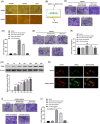Secreted TRAIL gene-modified adipose-derived stem cells exhibited potent tumor-suppressive effect in hepatocellular carcinoma cells
- PMID: 33156578
- PMCID: PMC7860607
- DOI: 10.1002/iid3.372
Secreted TRAIL gene-modified adipose-derived stem cells exhibited potent tumor-suppressive effect in hepatocellular carcinoma cells
Abstract
Objective: Considering the potential of adipose-derived stem cells (ADSCs) migrating towards cancer cells, this study was performed to explore the function of tumor necrosis factor-related apoptosis-inducing ligand (TRAIL) modified ADSCs on the development and progression of hepatocellular carcinoma (HCC).
Methods: ADSCs were extracted from human adipose tissues and identified through immunofluorescence and flow cytometry. Oil red staining and alizarin red staining were performed to clarify the differentiation potential of ADSCs. AAV-CMV-sTRAIL was transfected into ADSCs before Western blot and Transwell measurements. sTRAIL-ADSCs were cocultured with HCC cells to explore its effect on the proliferation and apoptosis of HCC cells. The possible effect of sTRAIL-ADSCs or ADSCs on tumor growth and metastasis was determined in vivo using xenograft nude mouse models.
Results: ADSCs were successfully extracted from adipose tissues, which were confirmed by cell morphology and positive expressions of CD44 and CD105. ADSCs were found with differentiation potential. After transfection, TRAIL was stably expressed in sTRAIL-ADSCs. Both ADSCs and sTRAIL-ADSCs can migrate towards HCC cells. In addition, sTRAIL-ADSCs can promote the cell apoptosis and inhibit cell proliferation in vitro, on parallel it can also suppress epithelial-mesenchymal transition, tumor growth, and metastasis in vivo.
Conclusion: TRAIL modified ADSCs can migrate towards HCC cells to inhibit tumor growth and the metastasis of implanted HCC tumors, which hints TRAIL modified ADSCs may be a new therapeutic approach for HCC treatment.
Keywords: TNF-related apoptosis-inducing ligand; adipose-derived stem cells; apoptosis; gene modification; hepatocellular carcinoma; metastasis; migration; tumor growth.
© 2020 The Authors. Immunity, Inflammation and Disease published by John Wiley & Sons Ltd.
Conflict of interest statement
The authors declare that there are no conflict of interests.
Figures





Similar articles
-
Potential Consequences of the Use of Adipose-Derived Stem Cells in the Treatment of Hepatocellular Carcinoma.Int J Mol Sci. 2024 Jul 17;25(14):7806. doi: 10.3390/ijms25147806. Int J Mol Sci. 2024. PMID: 39063048 Free PMC article. Review.
-
[Interleukin-12 enhanced tumor necrosis factor related apoptosis-inducing ligand TRAIL-induced apoptosis in human hepatocellular carcinoma by inhibiting expression of survivin].Zhonghua Wai Ke Za Zhi. 2003 Jun;41(6):453-7. Zhonghua Wai Ke Za Zhi. 2003. PMID: 12895357 Chinese.
-
[Adeno-associated virus mediated tumor necrosis factor related apoptosis inducing ligand gene transfected into hepatocellular carcinoma cells by ultrasound microbubble intensifier: an experimental study].Zhonghua Yi Xue Za Zhi. 2008 Jul 8;88(26):1846-50. Zhonghua Yi Xue Za Zhi. 2008. PMID: 19040022 Chinese.
-
Combined therapy with oncolytic adenoviruses encoding TRAIL and IL-12 genes markedly suppressed human hepatocellular carcinoma both in vitro and in an orthotopic transplanted mouse model.J Exp Clin Cancer Res. 2016 May 6;35:74. doi: 10.1186/s13046-016-0353-8. J Exp Clin Cancer Res. 2016. PMID: 27154307 Free PMC article.
-
Exploring the dynamic role of circulating soluble tumor necrosis factor-related apoptosis-inducing ligand (TRAIL) as a diagnostic and prognostic marker; a review.Biochem Biophys Res Commun. 2025 Mar 5;751:151415. doi: 10.1016/j.bbrc.2025.151415. Epub 2025 Jan 28. Biochem Biophys Res Commun. 2025. PMID: 39923464 Review.
Cited by
-
Mesenchymal stem cell-based TRAIL delivery inhibits the metastatic state of clinical therapy-resistant progressive neuroblastoma.World J Pediatr. 2024 Mar;20(3):287-293. doi: 10.1007/s12519-023-00769-9. Epub 2023 Dec 7. World J Pediatr. 2024. PMID: 38060141 No abstract available.
-
The Role of TRAIL Signaling in Cancer: Searching for New Therapeutic Strategies.Biology (Basel). 2024 Jul 15;13(7):521. doi: 10.3390/biology13070521. Biology (Basel). 2024. PMID: 39056714 Free PMC article. Review.
-
The inhibitory effect of human umbilical cord mesenchymal stem cells expressing anti-HAAH scFv-sTRAIL fusion protein on glioma.Front Bioeng Biotechnol. 2022 Nov 8;10:997799. doi: 10.3389/fbioe.2022.997799. eCollection 2022. Front Bioeng Biotechnol. 2022. PMID: 36425649 Free PMC article.
-
Potential Consequences of the Use of Adipose-Derived Stem Cells in the Treatment of Hepatocellular Carcinoma.Int J Mol Sci. 2024 Jul 17;25(14):7806. doi: 10.3390/ijms25147806. Int J Mol Sci. 2024. PMID: 39063048 Free PMC article. Review.
-
Regulation of Cancer Metastasis by TRAIL/Death Receptor Signaling.Biomolecules. 2021 Mar 26;11(4):499. doi: 10.3390/biom11040499. Biomolecules. 2021. PMID: 33810241 Free PMC article. Review.
References
-
- Llovet JM, Zucman‐Rossi J, Pikarsky E, et al. Hepatocellular carcinoma. Nat Rev Dis Primers. 2016;2:16018. - PubMed
-
- Wang J, Li N, Huang ZB, et al. HBx regulates transcription factor PAX8 stabilization to promote the progression of hepatocellular carcinoma. Oncogene. 2019;38:6696‐6710. - PubMed
-
- Ozakyol A. Global epidemiology of hepatocellular carcinoma (HCC epidemiology). J Gastrointest Cancer. 2017;48:238‐240. - PubMed
-
- Kawai T, Yasuchika K, Ishii T, et al. Keratin 19, a cancer stem cell marker in human hepatocellular carcinoma. Clin Cancer Res. 2015;21:3081‐3091. - PubMed
Publication types
MeSH terms
Substances
LinkOut - more resources
Full Text Sources
Medical
Miscellaneous

